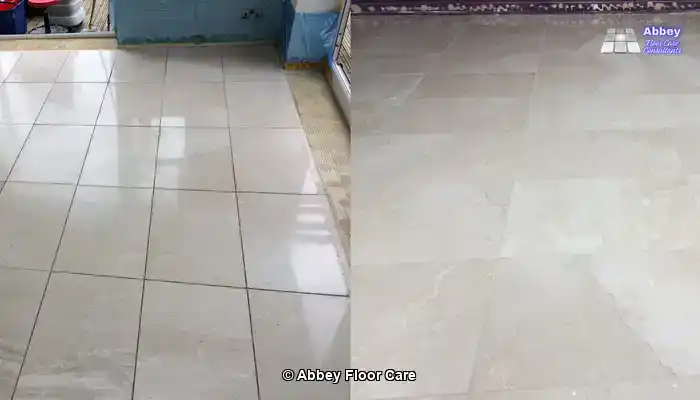
Last Updated on November 6, 2025 by David
Can You Truly Restore Marble to Its Original Splendour?

Expert Marble Care Strategies for Homeowners Across the UK
Marble, renowned for its elegance and sophistication, is a highly coveted flooring material that adds a touch of luxury to any home. However, as time passes, it can lose its original clarity, colour, and shine, diminishing its aesthetic appeal. Homeowners often grapple with issues such as scratches, dull patches, etch marks, and stubborn stains, leading to concerns about whether their cherished marble can ever restore its “like new” appearance. This extensive guide delves into the realistic potential of restoration, defining its boundaries while providing practical advice on maintaining the results for the long term. Whether you are dealing with acid damage, severe wear, or a tired surface, gaining insights into the restoration process enables you to make informed decisions about your stone’s future.
What Does “Like New” Mean in the Context of Marble Restoration?
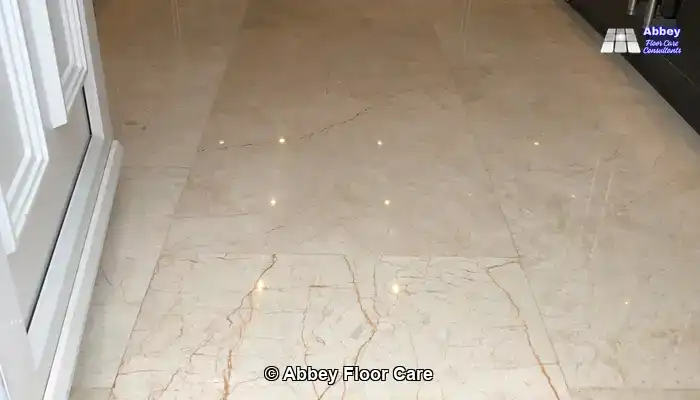
Revitalise Your Marble’s Original Shine, Clarity, and Colour
When homeowners express a longing for their marble to exhibit a “like new” appearance, they are typically referring to the original shine and clarity that allows light to dance across the surface, revealing the stone's natural colour depth. A successful restoration process can recreate this breathtaking effect by effectively eliminating surface damage while achieving a meticulously refined finish. The outcome is a floor that looks vibrant, smooth, and impeccably clean, often appearing indistinguishable from a newly installed slab. It is essential to recognise that reaching this level of restoration demands expertise and the right techniques to ensure results that last.
How Can You Differentiate Between Cosmetic Wear and Structural Damage in Marble?
Understanding the distinction between cosmetic wear and deeper structural issues is crucial when assessing your marble. Surface scratches, dullness, and light etching can typically be addressed through honing and polishing techniques. However, more severe issues, such as cracks, chips, and internal discolouration, may not completely disappear. While restoration can significantly enhance the visible and tactile aspects of the marble, it does not reconstruct the stone itself. Having a clear understanding of these differences will help set realistic expectations, ensuring satisfaction with the final outcome.
What Are the Limitations of Marble Restoration: Understanding Its Capabilities?
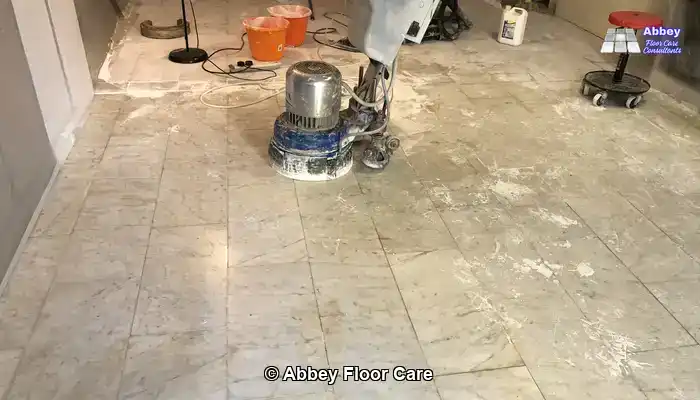
How Can You Effectively Address Deep Scratches, Chips, and Acid Etching in Marble?
Restoration processes are adept at eliminating most surface-level damage, including scratches and mild etching caused by acidic substances such as lemon juice or vinegar. These marks can dull the finish and obscure the stone’s inherent clarity. However, honing and polishing techniques can generally restore a smooth, reflective surface. Deep scratches and chips may necessitate more intensive methods, such as grinding or filling. While the overall appearance can improve significantly, some flaws may persist, remaining faintly visible depending on their depth and location within the stone.
What Are the Indicators of UV Damage and Internal Discolouration in Marble?
Marble exposed to strong sunlight over time may suffer from fading or yellowing.
Here’s a breakdown of the reasons for this phenomenon:
UV Ray Damage (Fading): Sunlight, particularly its ultraviolet (UV) rays, can lead to the natural pigments within the stone fading over time. This photochemical reaction diminishes the vibrancy of the colour, giving it a “washed out” appearance. This effect is particularly noticeable in certain marble colours.
-
- <a href=”https://www.abbeyfloorcare.co.uk/home-garden/travertine-floor-cleaning-service-expert-solutions/”>Yellowing</a>: Yellowing in white marble often occurs due to prolonged exposure to UV light, which accelerates the natural discolouration process.
- Iron Oxidation: Many types of white marble contain trace amounts of iron. When exposed to moisture and oxidisers (like air or water), this iron can rust, a process that sunlight and heat can exacerbate, leading to yellow or brown discolouration.
- Surface Degradation: UV rays can also degrade sealants or resins applied to the marble, causing a yellowing effect and dulling the overall surface appearance.
While marble is a robust material, it is more vulnerable to UV-induced changes than harder stones like granite or quartzite. This consideration is especially crucial for marble used in outdoor settings or indoor areas that receive prolonged, intense, direct sunlight (for instance, a sunny windowsill or near a large, unshaded window).
To effectively protect your marble surfaces, it is often advisable to utilise:
- UV-resistant sealants that shield the surface from harmful rays
- Shades, blinds, or curtains for indoor installations
- Proper placement to limit exposure to direct sunlight.
While restoration can enhance the surface appearance, it cannot reverse colour changes that have originated beneath the surface of the marble.
What Insights Do Before and After Images of Marble With Iron Oxide Stains Provide?
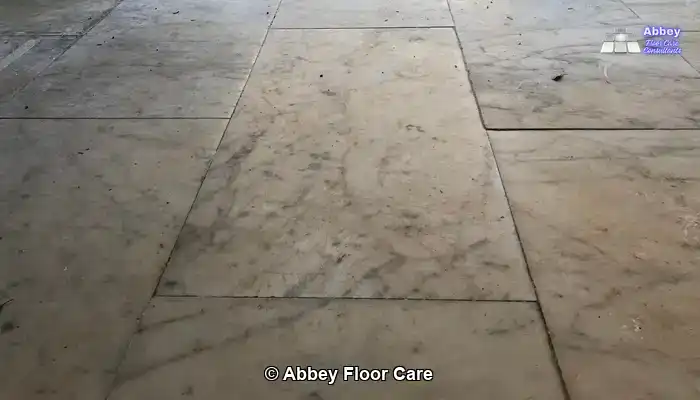
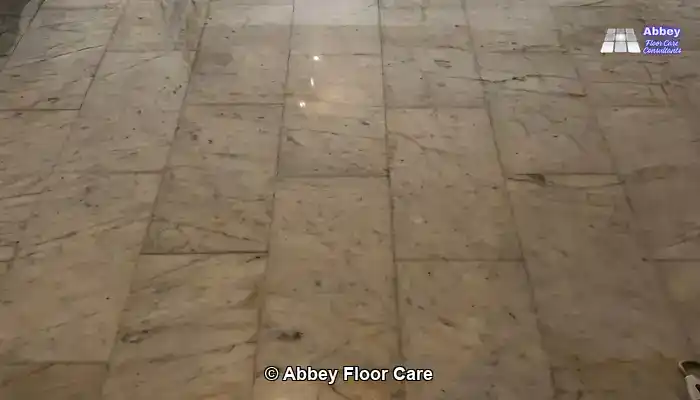
In instances such as these, the objective shifts from achieving a “like new” appearance to creating a cleaner, more uniform finish that minimises visual distractions while enhancing the overall aesthetic of the space.
What Are the Core Processes Involved in Honing, Polishing, and Full Restoration of Marble?
When Is It Sufficient to Simply Polish Marble for Restoration?
Polishing serves as a surface-level treatment designed to restore shine by smoothing out fine scratches and enhancing the reflectivity of the marble. This method is particularly effective for dull marble that remains otherwise intact. If the stone has lost its gloss due to light wear or minor etching, polishing alone may be adequate to restore a “like new” appearance. However, it is vital to recognise that polishing will not resolve deeper flaws or rectify uneven surfaces that necessitate more comprehensive treatment.
When Should You Consider Honing or Grinding for Marble Restoration?
Honing involves a more comprehensive process than polishing, as it removes a thin layer of the marble to eliminate scratches, etch marks, and surface damage. In cases of more significant wear, grinding may be essential to level the stone and completely reset the finish. These processes are more intensive but yield remarkable results. When homeowners aspire to achieve a truly fresh surface — one that looks and feels like new — honing or grinding is often the necessary step to reach that level of restoration.
How Do DIY Kits Measure Up Against Professional Restoration for Marble?
What Realistic Outcomes Can Be Achieved with DIY Kits for Marble Restoration?
DIY marble restoration kits generally include polishing powders, sealers, and basic tools designed to improve surface shine and diminish the appearance of light etching. For small areas or minor dullness, these kits offer a budget-friendly solution to refresh the stone. However, it is crucial to understand that they seldom deliver a genuine “like new” finish. Without access to professional-grade abrasives and specialised machinery, deeper imperfections frequently remain unaddressed, leading to inconsistent results across different areas of the marble.
Why Are Professional Tools Indispensable in Marble Restoration Processes?
Professional restoration extends beyond basic tools, incorporating diamond abrasives, rotary machines, and graded polishing compounds that function in a staged process. This advanced equipment enables skilled technicians to level the surface, eliminate deep damage, and refine the finish with exceptional precision. DIY kits simply lack the power and control necessary for achieving consistent results over larger areas. For homeowners seeking a flawless, enduring outcome, employing professional tools and expertise can significantly influence the final appearance of the marble.
How Long Can You Anticipate the Restored Marble Appearance to Endure?
What Are the Essential Steps for Sealing, Cleaning, and Managing Wear Patterns?
Once the restoration process is completed, sealing the marble becomes a critical step that aids in preserving the finish by blocking moisture and reducing stain absorption. A high-quality sealer can offer protection for a period of 1 to 3 years, depending on the level of foot traffic and usage. Regular cleaning of the marble with pH-neutral products while steering clear of abrasive pads or acidic spills will greatly prolong the life of the restored surface. In high-traffic areas, the finish may gradually dull over time; however, with diligent care, the clarity and shine of the marble can be retained for many years.
Can Restoration Be Repeated for Ongoing Maintenance of Marble?
Absolutely, marble restoration is a repeatable process. If the surface becomes dull or scratched again, it can be rehoned and repolished to restore its former glory. Nevertheless, it is essential to note that each cycle will remove a small amount of stone, so it is prudent to avoid excessive wear between treatments. Homeowners who maintain a consistent upkeep routine — which includes resealing and gentle cleaning — will discover that restoration remains a worthwhile investment over time, ensuring their marble stays beautiful and well-maintained.
Will Restored Marble Continue to Age and Develop Patina Over Time?
What Distinguishes Natural Patina from Artificial Gloss in Restored Marble?
Even after undergoing restoration, marble will continue to age naturally. Over time, subtle wear patterns, micro-abrasions, and environmental exposure contribute to the formation of a soft patina — a gentle sheen that reflects the stone’s unique history. This natural evolution contrasts with the artificial gloss created through polishing and sealing. A restored surface may initially appear brand new, but as time passes, it will gradually develop character once more. For many homeowners, this evolving finish adds charm and authenticity, particularly in older properties where marble is a vital aspect of the home’s narrative and aesthetic.
What Frequently Asked Questions Do Surrey Homeowners Have About Marble Restoration?
What Are the Typical Costs Associated with Marble Restoration in Surrey?
The expenses tied to marble restoration can vary based on multiple factors, including the size of the area, the condition of the marble, and the extent of restoration needed. Light polishing typically proves to be more affordable compared to comprehensive grinding and honing. In Surrey, homeowners often consider restoration when the marble is situated in a highly visible area or as part of a long-term property enhancement strategy. While prices can differ substantially, the true value lies in preserving the stone and elevating the overall appeal of the home.
Can All Types of Marble Be Successfully Restored?
Most types of marble can indeed undergo restoration, yet the achievable results will depend on the stone’s specific composition and current condition. Softer marbles may show signs of wear more rapidly and respond positively to polishing techniques. In contrast, harder varieties may require more aggressive honing methods. Some exotic stones, characterised by heavy veining or significant colour variation, may not return to a uniform finish after restoration. A professional assessment is essential in determining what is realistically attainable for your particular flooring.
Will the Restored Finish Match the Original Marble Installation?
The primary goal of restoration is to recreate the original finish; however, the degree of exact matching will depend on how the marble was initially installed and treated. If the stone underwent factory polishing, the restored surface may exhibit slight differences in gloss level or texture. Nevertheless, most homeowners find the end result visually consistent and markedly more appealing than the worn surface they began with. The emphasis is on improvement rather than perfection — and in most cases, the transformation is remarkable.
The Article Will Restored Marble Ever Look As Good As New first found on https://www.abbeyfloorcare.co.uk
The Article Restored Marble: Can It Achieve a Like-New Finish? appeared first on https://fabritec.org
The Article Restored Marble: Achieving a Like-New Finish Was Found On https://limitsofstrategy.com

